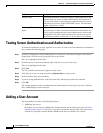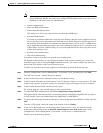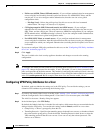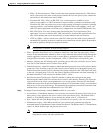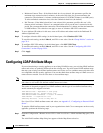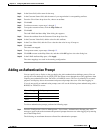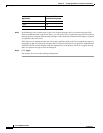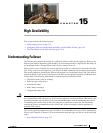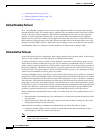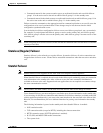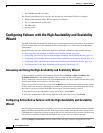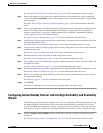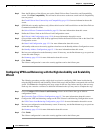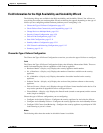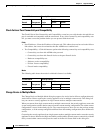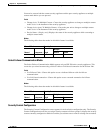
15-2
Cisco ASDM User Guide
OL-16647-01
Chapter 15 High Availability
Understanding Failover
• Active/Active Failover, page 15-2
• Stateless (Regular) Failover, page 15-3
• Stateful Failover, page 15-3
Active/Standby Failover
In an Active/Standby configuration, the active security appliance handles all network traffic passing
through the failover pair. The standby security appliance does not handle network traffic until a failure
occurs on the active security appliance. Whenever the configuration of the active security appliance
changes, it sends configuration information over the failover link to the standby security appliance.
When a failover occurs, the standby security appliance becomes the active unit. It assumes the IP and
MAC addresses of the previously active unit. Because the other devices on the network do not see any
changes in the IP or MAC addresses, ARP entries do not change or time out anywhere on the network.
Active/Standby failover is available to security appliances in single mode or multiple mode.
Active/Active Failover
In an Active/Active failover configuration, both security appliances pass network traffic. Active/Active
failover is only available to security appliances in multiple context mode.
To enable Active/Active failover on the security appliance, you need to create failover groups. If you
enable failover without creating failover groups, you are enabling Active/Standby failover. A failover
group is simply a logical group of one or more security contexts. You can create two failover groups on
the security appliance. You should create the failover groups on the unit that will have failover group 1
in the active state. The admin context is always a member of failover group 1. Any unassigned security
contexts are also members of failover group 1 by default.
As in Active/Standby failover, each unit in an Active/Active failover pair is given a primary or secondary
designation. Unlike Active/Standby failover, this designation does not indicate which unit is active when
both units start simultaneously. Each failover group in the configuration is given a primary or secondary
role preference. This preference determines on which unit in the failover pair the contexts in the failover
group appear in the active state when both units start simultaneously. You can have both failover groups
be in the active state on a single unit in the pair, with the other unit containing the failover groups in the
standby state. However, a more typical configuration is to assign each failover group a different role
preference to make each one active on a different unit, balancing the traffic across the devices.
Initial configuration synchronization occurs when one or both units start. This synchronization occurs
as follows:
• When both units start simultaneously, the configuration is synchronized from the primary unit to the
secondary unit.
• When one unit starts while the other unit is already active, the unit that is starting up receives the
configuration from the already active unit.
After both units are running, commands are replicated from one unit to the other as follows:
• Commands entered within a security context are replicated from the unit on which the security
context appears in the active state to the peer unit.
Note A context is considered in the active state on a unit if the failover group to which it belongs is
in the active state on that unit.



